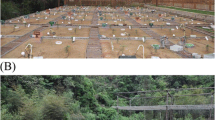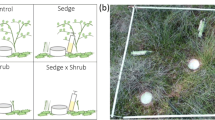Abstract
The impacts of global climatic change on belowground ecological processes of terrestrial ecosystems are still not clear. We therefore conducted an experiment in the subalpine coniferous forest ecosystem of the eastern edges of the Tibetan Plateau to study roots of Picea asperata seedlings and rhizosphere soil responses to soil warming and nitrogen availability from April 2007 to December 2008. The seedlings were subjected to two levels of temperature (ambient; infrared heater warming) and two nitrogen levels (0 or 25 g m−2year−1 N). We used a free air temperature increase from an overhead infrared heater to raise both air and soil temperature by 2.1 and 2.6°C, respectively. The results showed that warming alone significantly increased total biomass, coarse root biomass and fine root biomass of P. asperata seedlings. Both total biomass and fine root biomass were increased, but coarse root biomass was significantly decreased by nitrogen fertilization and warming combined with nitrogen fertilization. Warming induced a prominent increase in soil organic carbon (SOC) and NO3 −-N of rhizosphere soil, while nitrogen fertilization significantly decreased SOC and NH4 +-N of rhizosphere soil. The warming, fertilization and warming × N fertilization interaction decreased soil microbial C significantly, but substantially increased soil microbial N. These results suggest that nitrogen deposition combined with warmer temperatures under future climatic change possibly will have no effect on fine root production of P. asperata seedlings, but could enhance the nitrification process of their rhizosphere soils in subalpine coniferous forests.



Similar content being viewed by others
Abbreviations
- CO2 :
-
Carbon dioxide
- CR/FR:
-
Coarse root/fine root mass ratio
- CRM:
-
Coarse root mass
- FRM:
-
Fine root mass
- FRV:
-
Fine root vigor
- MBC:
-
Microbial biomass carbon
- MBN:
-
Microbial biomass nitrogen
- N:
-
Nitrogen
- NPP:
-
Net primary productivity
- R/S:
-
Root/shoot mass ratio
- RL:
-
Root length
- SOC:
-
Soil organic carbon
- SRL:
-
Specific root length
- STN:
-
Soil total nitrogen
References
Aber JD, McDowell W, Nadelhofer K, Magill A, Berntson G, Kamakea M, McNulty S, Currie W, Rustad L, Fernandez I (1998) Nitrogen saturation on in temperate forest ecosystems: hypotheses revisited. Bioscience 48:921–934
Antoninka A, Wolf JE, Bowker M, Classen AT, Johnson AC (2009) Linking above- and belowground responses to global change at community and ecosystem scales. Glob Change Biol 15:914–929
Badalucco L, Kuikman P (2001) Mineralization and immobilization in the rhizosphere. In: Pinton R, Varanini Z, Nannipieri P (eds) The rhizosphere. biochemistry and organic substances at the soil–plant interface. Dekker, New York, pp 159–196
Bergh J, Linder S, Lundmark T, Elfving B (1999) The effect of water and nutrient availability on the productivity of Norway spruce in northern and southern Sweden. For Ecol Manage 119:51–62
Brookes PC, Landman A, Pruden G, Jenkinson DS (1985) Chloroform fumigation and the release of soil nitrogen: a rapid extraction method to measure microbial biomass nitrogen in soil. Soil Biol Biochem 17:837–842
Cabrera ML, Beare MH (1993) Alkaline persulfate oxidation for determining total nitrogen in microbial biomass extracts. Soil Sci Soc Am J 57:1007–1012
Christie P, Beattie JAM (1989) Grassland soil microbial biomass and accumulation of potentially toxic metals from long-term slurry application. J Appl Ecol 26:597–612
Cleveland CC, Townsend AR (2006) Nitrogen and phosphorus additions cause substantial losses of soil carbon from a lowland tropical rain forest. Proc Natl Acad Sci USA 103:10316–10321
Danby RK, Hik DS (2007) Responses of white spruce (Picea glauca) to experimental warming at a subarctic alpine treeline. Glob Change Biol 13:437–451
Day TA, Christopher T, Ruhland CT, Sheng FU, Xiong S (2008) Warming increases aboveground plant biomass and C stocks in vascular-plant-dominated Antarctic tundra. Global Change Biol 14:1827–1843
Eissenstat DM, Yanai R (1997) Ecology of root lifespan. Adv Ecol Res 27:1–62
Emmett BA, Kjnaas OJ, Gundersen P, Koopmans C, Tietema A, Sleep D (1998) Natural abundance of 15N in forests across a nitrogen deposition gradient. For Ecol Manage 101:9–18
Farnsworth EJ, Nunez-Farfan J, Careaga SA, Bazzaz FA (1995) Phenology and growth of three temperate forest life forms in response to artificial soil warming. J Ecol 83:967–977
Fitter AH, Graves JD, Watkins NK, Robinson D, Scrimgeour C (1998) Carbon transfer between plants and its control in networks of arbuscular mycorrhizas. Funct Ecol 12:406–412
Gallardo A, Schlesinger WH (1992) Carbon and nitrogen limitations of soil microbial biomass in desert ecosystems. Biogeochemistry 18:1–17
Hines J, Megonigal JP, Denno RD (2006) Nutrient subsidies to belowground microbes impact aboveground food web interactions. Ecology 87:1542–1555
Johnson MG, Rygiewicz PT, Tingey DT, Phillips DL (2006) Elevated CO2 and elevated temperature have no effect on Douglas-fir fine-root dynamics in nitrogen-poor soil. New Phytol 17:345–356
Jonasson S, Michelsen A, Schmidt IK, Nielsen EV (1999) Responses in microbes and plants to changed temperature, nutrient, and light regimes in the arctic. Ecology 80:1828–1843
Kemmitt SJ, Lanyon CV, Waite IS, Wen Q, Addiscott TM, Bird NRA, O’Donnell AG, Brookes PC (2008) Mineralization of native soil organic matter is not regulated by the size, activity or composition of the soil microbial biomass—a new perspective. Soil Biol Biochem 40:61–73
Kroon H de, Visser EJW (eds) (2003) Root ecology, vol 168. Springer, Berlin
Lavian IL, Vishneretsky S, Barness G, Steinberger Y (2001) Soil microbial community and bacterial functional diversity at Machu Picchu, King George Island, Antarctica. Polar Biol 24:411–416
Li HS (2000) Principles and techniques of plant physiological experiment (in Chinese). Higher Education Press, Beijing, pp 119–120
Li DJ, Mo JM, Fang YT, Pen SL, Gundersen P (2003) Impact of nitrogen deposition on forest plants. Acta Ecol Sin 23:1891–1900
Lovell RD, Jarvis SC, Bardgett RD (1995) Soil microbial biomass and activity in long-term grassland: effects of management changes. Soil Biol Biochem 27:969–975
Lu WD, Zhu YL, Sha J, Zhu HB (1997) SPSS for windows. Electronic Industry Press, Beijing, pp 287–290
Luxmoore RJ, Hanson PJ, Beauchamp JJ, Joslin JD (1998) Passive nighttime warming facility for forest ecosystems research. Tree Physiol 18:615–623
Majdi H, Öhrvik J (2004) Interactive effects of soil warming and fertilization on root production, mortality, and longevity in a Norway spruce stand in Northern Sweden. Glob Change Biol 10:182–188
Malhi SS, Nyborg M, Harapiak JT (1998) Effects of long-term N fertilizer-induced acidification and liming on micronutrients in soil and in bromegrass hay. Soil Tillage Res 48:98–101
Matson PA, Lohse KA, Hall SJ (2002) The globalization of nitrogen deposition: consequences for terrestrial ecosystems. Ambio 31:113–119
Mellilo JM, Seeudler PA, Aber JD, Newkirk K, Lux H, Bowles FP, Catricala C, Magill A, Ahrens T, Momisseau S (2002) Soil warming and carbon-cycle feedbacks to the climate systems. Science 298:2173–2176
Michelsen A, Graglia E, Schmidt IK, Jonasson S, Sleep D, Quarmby C (1999) Differential responses of grass and a dwarf shrub to long-term changes in soil microbial biomass C, N and P following factorial addition of NPK fertilizer, fungicide and labile carbon to a heath. New Phytol 143:523–538
Mo JM, Xue LH, Fang YT (2004) Litter decomposition and its responses to simulated N deposition forthe major plants of Dinghnshan forests in subtropical China. Acta Ecol Sin 24:1413–1420
Morgan JA, Hunt HW, Monz CA, LeCain DR (1994) Consequences of growth at two carbon dioxide concentrations and two temperatures for leaf gas exchange in Pascopyrum smithii (C3) and Bouteloua gracilis (C4). Plant Cell Environ 17:1023–1033
Nakaji T, Fukami M, Dokiya Y, Izuta T (2001) Effects of high nitrogen load on growth, photosynthesis and nutrient status of Cryptomeria japonica and Pinus densiflora seedlings. Trees 15:453–461
Niu S, Wu M, Han Y, Xia J, Li L, Wan S (2008) Water-mediated responses of ecosystem C fluxes to climatic change in a temperate steppe. New Phytol 177:209–219
Phillips RP, Fahey TJ (2007) Fertilization effects on fineroot biomass, rhizosphere microbes and respiratory fluxes in hardwood forest soils. New Phytol 176:655–664
Pregitzer KS, Burton AJ, King JS, Zak DR (2008) Soil respiration, root biomass, and root turnover following long-term exposure of northern forests to elevated atmospheric CO2 and tropospheric O3. New Phytol 180:153–161
Rasse DP (2002) Nitrogen deposition and atmospheric CO2 interactions on fine root dynamics in temperate forests: a theoretical model analysis. Glob Change Biol 8:486–503
Ross DJ, Tate KR, Newton PCD (1995) Elevated CO2 and temperature effects on soil carbon and nitrogen cycling in ryegrass/white clover turves of an endoaquept soil. Plant Soil 176:37–49
Rustad LE, Campbell JL, Marion GM, Norby RJ, Mitchell MJ, Hartley AE, Cornelissen JHC, Gurevitch J (2001) A meta-analysis of the response of soil respiration, net nitrogen mineralization, and aboveground plant growth to experimental ecosystem warming. Oecologia 126:543–562
Schimel JP, Weintraub MN (2003) The implications of exoenzyme activity on microbial carbon and nitrogen limitation in soil: a theoretical model. Soil Biol Biochem 35:1–15
Turner KM, Treseder KK (2004) Nitrogen additions affect root dynamics in a boreal forest ecosystem. American Geophysical Union, Fall Meeting 2004, abstract #B13B-0218
Van Cleve C, Oechel WC, Hom JL (1990) Response of black spruce (Picea mariana) ecosystems to soil temperature modification in interior Alaska. Can J For Res 20:1530–1535
Van Noordwijk M, Martikainen PJ, Bottner P, Cueva E, Rouland C, Dhillion SS (1998) Global change and root function. Glob Change Biol 4:759–772
Vance ED, Brookes PC, Jenkinson DS (1987) An extraction method for measuring soil microbial biomass C. Soil Biol Biochem 19:703–707
Wan S, Luo Y, Wallance L (2002) Changes in microclimate induced by experimental warming on ecosystem carbon processes in a tallgrass prairie. Glob Change Biol 8:754–768
Wan S, Hui D, Wallace L, Luo Y (2005) Direct and indirect effects of experimental warming on ecosystem carbon processes in a tallgrass prairie. Glob Biogeochem Cycles 19:1–13
Welker M, Brunke M, Preussel K, Lippert I, vonDöHren H (2004) Diversity and distribution of Microcystis (Cyanobacteria) oligopeptide chemotypes from natural communities studied by single colony mass spectrometry. Microbiology SGM 150:1785–1796
Xia J, Han Y, Zhang Z, Zhang Z, Wan S (2009) Effects of diurnal warming on soil respiration are not equal to the summed effects of day and night warming in a temperate steppe. Biogeosci 6:1361–1370
Xu RK, Coventry DR (2003) Soil pH changes associated with lupin and wheat plant materials incorporated in a redbrown earth soil. Plant Soil 250:113–119
Yao XQ, Liu Q (2007) Changes in photosynthesis and antioxidant defenses of Picea asperata seedlings to enhanced ultraviolet-B and to nitrogen supply. Physiol Planta 129:364–374
Yin HJ, Liu Q, Lai T (2008) Warming effects on growth and physiology in the seedlings of the two conifers Picea asperata and Abies faxoniana under two contrasting light conditions. Ecol Res 23:459–469
Zhang W, Parker KM, Luo Y, Wan S, Wallace LL, Hu S (2005) Soil microbial responses to experimental warming and clipping in a tallgrass prairie. Glob Change Biol 11:266–277
Zhang NL, Wan SQ, Li LH, Bi J, Zhao MM, Ma KP (2008) Impacts of urea N addition on soil microbial community in a semi-arid temperate steppe in northern China. Plant Soil 311:19–28
Zhao CZ, Liu Q (2009a) Growth and physiological responses of Picea asperata seedlings to elevated temperature and to nitrogen fertilization. Acta Physiol Plant 31:163–173
Zhao CZ, Liu Q (2009b) Growth and photosynthetic responses of two coniferous seedlings to experiment warming and nitrogen fertilization. Can For Res 39:1–11
Acknowledgments
This study was funded jointly by the Key Program of the National Natural Science Foundation of China (30800165, 31070533), the program of “Knowledge Innovation Engineering” of the Chinese Academy of Sciences (No. KSCX2-YW-Z1023), the forefront project of Chengdu Institute of Biology, the Chinese Academy of Sciences (Y0B2021100). We are also indebted to Key Laboratory of Mountain Ecological Restoration and Bioresource Utilization, Chengdu Institute of Biology, Chinese Academy of Sciences and Ecological Restoration, Biodiversity Conservation Key Laboratory of Sichuan Province and Maoxian Ecological Station, Chengdu Institute of Biology, Chinese Academy of Sciences.
Author information
Authors and Affiliations
Corresponding author
About this article
Cite this article
Liu, Q., Yin, H., Chen, J. et al. Belowground responses of Picea asperata seedlings to warming and nitrogen fertilization in the eastern Tibetan Plateau. Ecol Res 26, 637–648 (2011). https://doi.org/10.1007/s11284-011-0824-5
Received:
Accepted:
Published:
Issue Date:
DOI: https://doi.org/10.1007/s11284-011-0824-5




